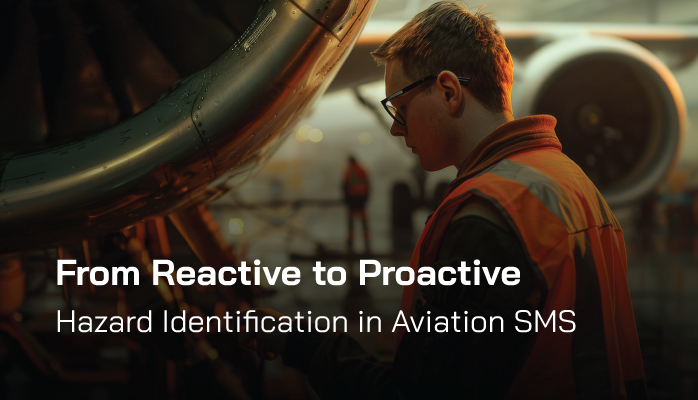Proactive Hazard Identification Saves Lives

Every aviation operation endures varying levels of risk, depending on ever-changing environmental conditions.
The operating environment never remains constant.
No two operations are identical.
Certain factors will always interject uncertainty and risk into the operation, including:
- Human;
- Equipment; and
- Environmental.
Related Aviation Hazard Identification Articles
- How to Identify Hazards in Aviation SMS
- 4 Tips to Approach Hazard Identification in Aviation SMS Programs
- Safety Chart: Where to Focus Hazard Identification
There are times when pilots and maintenance personnel need to determine in advance whether the operation they are about to undertake involves inordinately high levels of risk. Aviation service providers should deem it critical for both asset protection and risk management best practices to establish a review process for certain types of operations.
Here we'll explore the benefits of proactively identifying hazards and why many managers don't like to incorporate flight risk assessments into their daily operations.
What Is Reactive Risk Management?
We all practice reactive risk management every day. This is the simplest form of managing risk. In being reactive, we are responding to an event after it has already happened. In short, we are putting out the fire after it has started.
We will never get away from reacting to events as they surface. This is part of life. For example, imagine that a new, faster aircraft was designed. The aircraft has been tested and put into production. During this process, the manufacturer will uncover unforeseen design challenges causing mission degradation. For argument's sake, let's say that the aircraft vibrated excessively and shuddered uncontrollably at speeds greater than 450 knots. Again, this behavior was not foreseen in the design process, causing the engineers to react to
- determine the root cause,
- implement mitigation measures;
- resume monitoring for substandard performance.
Another example we can use is bird strikes. Bird strikes happen all the time. They are inevitable and controls have been developed in-depth to mitigate hazard-related consequences. But bird strikes happen and we must continually react by cleaning up the mess (an easy case) or repairing windscreens or replacing nose cones. The industry continues to react to this hazard despite all the implemented risk controls to prevent occurrence.
Where Is the End of Reactive Risk Management?
Some safety managers may feel that their SMS is not effective if they are always putting out fires, i.e., responding to events after they have happened. Do not fret! You will always be reacting to interactions with hazards as long as you are operating. Why? Because the environment constantly changes. New hazards regularly appear that are impossible to mitigate completely.
Do not become dismayed if many of your reported issues continue to be in response to an event. This is natural, but do not become complacent and think that reacting to events is the best practice. If bird strikes concern you and you are tired of "reacting," you may be interested in strategies for prevention of bird strikes and how to react to a bird strike.
Have You Read
- Difference Between Reactive, Predictive and Proactive Risk Management
- Checklist for Proactive Safety Culture in Aviation SMS Programs [With Free Resources]
- 3 Things Hurting Your Proactive Risk Management in Aviation SMS
What Is Proactive Risk Management?

Let's continue the bird strike scenario. We keep hitting birds and we keep reacting. It is costing us money to continue repairing aircraft and I want to reduce damages caused by hitting big birds.
Proactive risk management is controlling the situation by causing something else to happen instead of responding reactively to these events. Controlling the hazard, or controlling the interaction with the hazard may be performed by:
- Human interaction;
- Policies;
- Procedures; or
- Re-engineering the process.
How Do We Proactively Manage Risk?
In the case of bird strikes, there are several mitigation strategies to reduce the occurrence of bird strikes. Airports commonly re-engineer the habitat surrounding airports to reduce the food supply. Other proactive risk management strategies include:
- Sonic cannons;
- Trained domesticated animals (falcons, dogs);
- Bird detection and rerouting aircraft; and
- Adjusting aircraft schedules to avoid certain times of the day.
None of the above mitigation strategies eliminate the risk. But we are controlling the risk in advance to reduce the number of occurrences and if possible, the severity of interacting with the hazard (flying birds).
Proactive Hazard Identification for Individual Missions
Solid review processes include defenses in depth incorporating risk mitigation strategies at different points of the process.
Decisions to continue questionable operations are also more easily determined before starting the operation when repeatable, best practice review processes are incorporated. One can easily see how proactively identifying hazards can save lives and reduce the risk of incredibly expensive assets.
Hazard identification for pilots and maintenance personnel is not a new concept. For many years, the FAA has offered a Flight Risk Analysis Tool (FRAT).
Traditionally, the FRAT tool was either:
- A paper-based checklist; or
- An MS Excel spreadsheet.
The FRAT tool was broken into three sections:
- Man Power;
- Operating Environment; and
- Equipment.
Many companies have taken the FRAT to the next level, such as creating "apps" or Web-based assessment tools. While the FAA flight risk assessment checklist is a great start, most operators quickly learn that they will need to customize the checklist to suit their unique operations. Some private aviation safety software companies easily recognized the limitation and allowed operators to configure checklists by an administrator.
Another great addition to FRAT tools by aviation safety software companies was the inclusion of airports or landing areas. One can easily imagine that one airfield may possess different levels of risk than another. Hazards and associated risk may originate from mountainous terrain, short runways, crosswinds, etc.
Taken to another level, we realize that each airfield or landing area has varying levels of risk on both arrival and departure operations.
Related Articles on Risk in Aviation Operations
- Difference Between Hazards, Risks & Control Measures in Aviation SMS
- Difference Between Hazard Risk Assessment and Hazard Risk Analysis
- What Is Modern Aviation Risk Management Cycle - With SMS Resources
Resistance to Flight Risk Assessment Tool
When we introduced a configurable, Web-based flight risk assessment tool, we thought we made a clever and the most useful FRAT. This was the first Web-based FRAT on the market and we thought that every operator would find that pre-flight risk assessments would certainly lower risk by identifying potential hazards before each flight.
Unfortunately, we found that most upper management types didn't like the idea of FRAT. Their typical excuse was the time it takes to honestly evaluate each question and determine mitigation strategies would cut into the pilots' flight-duty time.
As we know, management is interested in generating revenue. When a pilot flies three times per day, and each FRAT takes ten minutes to complete, 30 minutes are daily spent performing tasks that ARE NOT REQUIRED.
In addition, many managers are afraid of leaving a paper trail. If a FRAT had been performed and the worst happened, there would be questions as to why management permitted the flight.
Flight Risk Assessments Becoming Standard Procedure
Well-designed FRAT tools become invaluable in helping aviation service providers make better go/no-go decisions and should become a part of every non-routine operation. Many operators have made it a requirement for pilots to perform a FRAT before each flight.
Routine flights may appear to afford little benefit; however, the process is lacking.
Why Incorporate Routine Flight Risk Assessments?

As stated above, many operators continue to fly the same route, day after day. What changes? The weather, for one. Other times a pilot may be required to fly another aircraft that he has less experience with.
The point is that for most operations, there may not be any red flags that require additional risk mitigation measures. However, there will always be that "one time" when you wished you had been better prepared or had not flown. Performing the FRAT does not eliminate risk, but it does help you to become aware and better prepared for daily hazards.
While some operators hope to receive insurance discounts due to the adoption of routine flight risk assessments, don't get your hopes up. The insurance company is in business to make money and you will have to make a strong business case for your insurance company during rate negotiations.
Routine Flight Risk Assessments Make Business Sense
Asset protection and avoiding loss of human life is in the interest of everyone. We appreciate risk management efforts, even more, when they contribute to the bottom line.
From our viewpoint, aviation service providers that adopt routine flight risk assessments seem to have highly motivated pilots who appear to have more job satisfaction. From the pilot's perspective, management is truly concerned with their well-being and safety.
The end-game is not always about performing the mission regardless of the risk.
How to Become More Proactive in Risk Management?
Do you have a strategy to become more proactive in your SMS? Do you want to go from putting out fires to keeping the fires from starting in the first place?
Keeping the fire from starting takes energy and commitment as your safety culture matures. You will also need tools to manage your hazards and risks, including processes to measure and monitor your risk management progress.
SMS Pro has the necessary tools to help you proactively manage hazards and continuously monitor control measures.
If you want to improve your risk management capabilities, please watch these videos to determine whether our partnership adds value to your organization. If you have questions or would like to see the SMS database live, sign up for a live demo.
Live SMS Pro Demo
Last updated January 2025.







